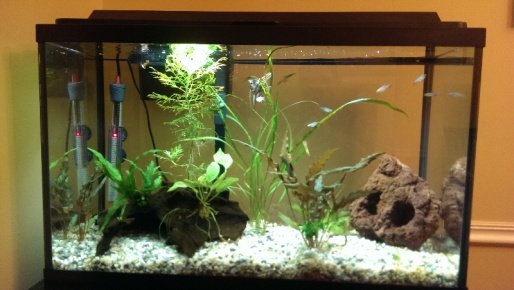malonbl
Aquarium Advice Activist
I don't want to become frustrated with it like I did 15 years ago when I tried. What I hope to do is purchase the proper lighting, start with hardy "beginner's plants" and understand the appropriate maintenance and/or fertilization protocol so that I can be successful.
Here are my tank specifics. 29 gallon with HOB filter. 17.5 inches tall. CaribSea supernaturals gravel (It is a small/fine gravel). I have lava rock, other stones and driftwood in the tank. Temperature around 77.5 degrees. I am just at the end of a fish-in cycle. I have 9 zebra danios. I plan to add another school of danios (cpd's), a school of small tetras and 4-5 cory cats.
I am sure my lighting is not sufficient, but I will tell you what I have just in case. BTW, I do not understand lighting language, so bear with me (I did read the lighting article linked at the top of this forum). My bulb is an aqueon fluorescent bulb with the following specs: 17w, T8, 24". The hood for the light states the following specs: 120 volt, 20w, 60 hz, 30"
I do not plan to supplement the tank with CO2, therefore I know that I don't need to provide too much light, but rather need to balance the appropriate lighting with the available CO2.
My knowledge is limited and my questions are broad, so for my sake (to keep it simple), let me ask two specific questions initially and then I will build on the topic in this thread with subsequent questions.
1) Are there any "fatal flaws" in my tank specifics that will make planting my tank difficult?
2) What is a specific light (brand, specs, etc) that I can purchase that is suitable for "beginners plants" within my specific tank setting?
By the way, I understand I need approximately 2 watts per gallon (since I don't have CO2 plans) and I think I need between 5,000 and 10,000K. I don't know what "K" is though or what particular spec on my bulb corresponds to "K"
Any help would be appreciated and please forgive my ignorance
Here are my tank specifics. 29 gallon with HOB filter. 17.5 inches tall. CaribSea supernaturals gravel (It is a small/fine gravel). I have lava rock, other stones and driftwood in the tank. Temperature around 77.5 degrees. I am just at the end of a fish-in cycle. I have 9 zebra danios. I plan to add another school of danios (cpd's), a school of small tetras and 4-5 cory cats.
I am sure my lighting is not sufficient, but I will tell you what I have just in case. BTW, I do not understand lighting language, so bear with me (I did read the lighting article linked at the top of this forum). My bulb is an aqueon fluorescent bulb with the following specs: 17w, T8, 24". The hood for the light states the following specs: 120 volt, 20w, 60 hz, 30"
I do not plan to supplement the tank with CO2, therefore I know that I don't need to provide too much light, but rather need to balance the appropriate lighting with the available CO2.
My knowledge is limited and my questions are broad, so for my sake (to keep it simple), let me ask two specific questions initially and then I will build on the topic in this thread with subsequent questions.
1) Are there any "fatal flaws" in my tank specifics that will make planting my tank difficult?
2) What is a specific light (brand, specs, etc) that I can purchase that is suitable for "beginners plants" within my specific tank setting?
By the way, I understand I need approximately 2 watts per gallon (since I don't have CO2 plans) and I think I need between 5,000 and 10,000K. I don't know what "K" is though or what particular spec on my bulb corresponds to "K"
Any help would be appreciated and please forgive my ignorance




